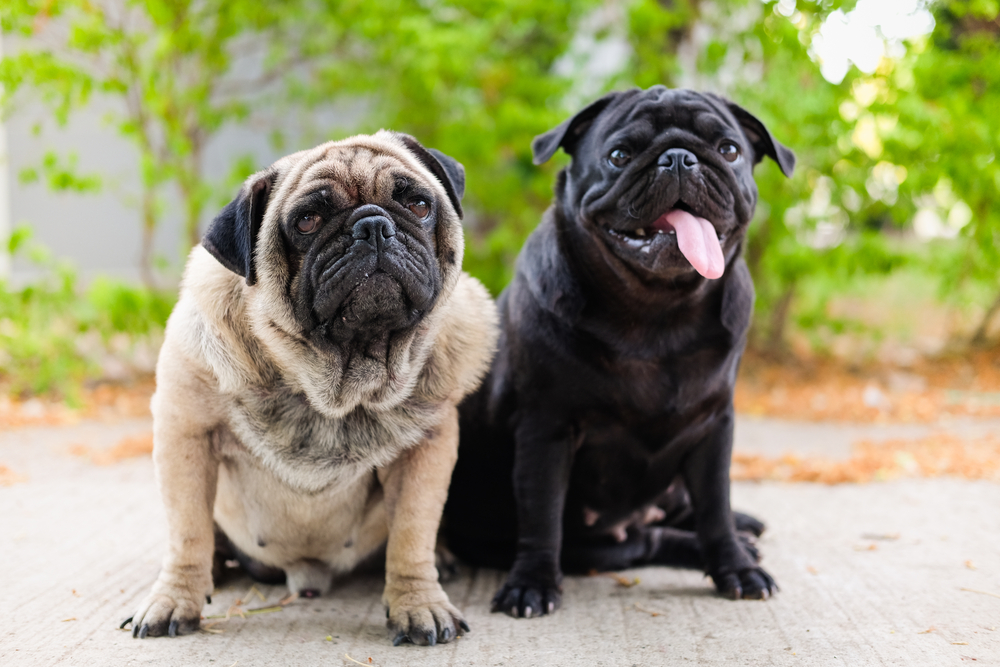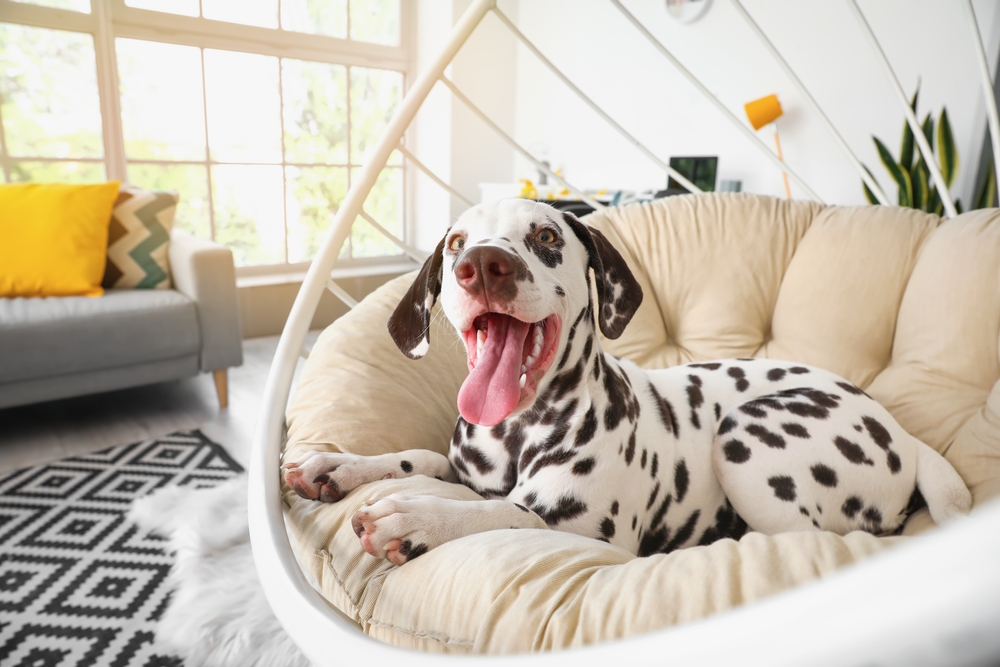Are you throwing a fresh lint roller into your cart every time you go to the grocery store, adding a daily vacuuming session to your chores roster, or accepting dog hair as an Avante Garde part of your wardrobe?
Shedding might seem like an inescapable part of pet parenthood, especially seasonal shedding. You may wonder, “Do dogs shed more in the summer?” if you own an adorable husky or golden. But, you can try a few time-tested tricks to improve your dog’s coat health and—in some cases—decrease their shed volume.
In this guide, we’ll explore eight potential solutions for excessive shedding in dogs. A combination of vigilance, improved grooming techniques, and diet changes could transform your mega-shedder into a hair health icon.
8 Solutions for Shedding
Is your dog shedding a lot? Whether you suspect seasonal changes, allergies, or a more significant underlying cause, the eight tips below could provide pups—and pet parents—with relief from excessive shedding.
#1 Talk to Your Vet
If your dog’s shedding has significantly increased in a short period of time, they’re starting to show signs of hair loss, or you observe other noticeable changes in their appearance or behavior, you should make an appointment with your vet to discuss potential underlying causes.
Hair loss and skin irritation can be symptoms of more severe issues that may not present other easily-identifiable symptoms, like:1
- A reaction to parasites, like ticks, fleas, lice, and mites
- Fungal, viral, or bacterial infections
- Seasonal, environmental, or food allergies
- Stress or anxiety
- Sunburn
- Immune issues
- Medication side effects
- Kidney, liver, or thyroid conditions
We don’t want to alarm pet parents—major shedding doesn’t always signify major health problems. But, any significant changes to your pet’s coat, skin, appearance, or behavior should be addressed with your vet in an effort to identify potential health issues as soon as possible.
#2 Step Up Your Brush Game
How often do you brush your dog? Brushing can help you keep your pet’s coat clean and shiny or even help you spot pesky skin conditions.
Brushing can also reduce your dog’s likelihood of shedding.2 By brushing the looser, weaker hairs from their skin, you can make way for stronger, healthier hairs to grow—they’ll fall out during the brushing process instead of littering your floor, collecting on your car seats, or floating aimlessly in the air.
Here are a few tips to brush like a pro:
- Start slowly – Your dog might not enjoy brushing at first. Offer them treats to help them associate grooming with a positive reward, giving extra treats when they sit still or endure longer sessions.
- Acclimate nervous pups – Depending on your dog’s history, they may have an adverse reaction to grooming tools—brushes included. Before graduating to a dog brush, start with wide-toothed human combs or hairbrushes to help your pup get used to the brushing sensation.
- Choose the right tools – Your dog’s coat will determine the most effective brush. If you’re not sure which tool to choose, ask your vet or groomer for tips.
#3 Bathe More Frequently
Like brushing, the agitating motions you use while bathing your dog can help loosen and dislodge weaker, looser hairs from your pup’s coat before they have a chance to be shed.
But, bathing offers other benefits that could lead to decreased shedding:3
- Healthier skin – Keeping your pet’s skin healthy, clean, and hydrated can provide a strong foundation for hair growth. Flaky, dry skin isn’t the best medium for newly-sprouted hairs.
- Increased blood flow – Regular bathing can promote increased blood flow and circulation in your dog’s skin, leading to increased cellular regeneration, a key element of maintaining healthy skin.
- Improved skin comfort – If your pup is prone to itching, regular and frequent baths can help soothe their sensitive skin, preventing scratching and associated hair loss. Use a soothing shampoo made with oatmeal or aloe to relieve any discomfort your pup may be experiencing.
#4 Watch Out for Wounds
As we briefly discussed in a previous section, excessive shedding in dogs can be a sign of more serious underlying conditions.
If you notice an uptick in shedding volumes, inspect your dog’s skin for wounds, including:
- Infected hot spots
- Scrapes, scratches, mand scabs
- Allergy rashes
- Sunburn
- New moles or inflamed skin markings
- Insect bites
For humans and dogs alike, healing from an injury can lead to increased dead skin cell shedding—and itching. If you’ve ever skinned your knee or suffered from a serious summertime sunburn, you’ve likely experienced itching during the healing process.
If you find a wound, consult your vet for help choosing appropriate protection, soothing, or disinfecting solutions. In addition, you may also want to consider providing your pet with some relief with CBD for dogs.

#5 Hydrate, Hydrate, Hydrate!
Hydration is just as important for dogs as it is for humans. Water contains important minerals like potassium, sodium, and chloride, all of which can help your pup:4
- Maintain a balanced pH level
- Perform critical cell functions
- Build and support muscles
- Regulate nervous system function
When your dog is dehydrated, you might observe various skin-related warning signs like reduced skin elasticity, a dull coat, dandruff, or increased shedding.
If you suspect that your pup might be under-hydrating, you can take a few steps to encourage healthy water intake with the following:
- Gelatin treats – Follow the instructions on an unflavored gelatin packet, replacing water with unflavored Pedialyte. Add a few dashes of chicken or beef broth (or a bouillon cube) for added flavor, and use an ice cube tray for convenient dosing. Cool your gelatin mixture per the instructions on the packet, and supplement your pup’s water intake with a few cubes of this electrolyte treat if you notice dehydration symptoms.
- Water commands – Just like you taught your dog to sit and stay, you can teach them to drink from their water bowl on command. Lure your pup to their water bowl with a treat, place it in the water bowl, and encourage them with praise and a command word, like “Good drink!” Reward them after they take a drink on command, and practice consistently to maintain the skill.
- Kibble soup – It might sound unappetizing to you, but adding an inch of water to the bottom of your dog’s kibble bowl and letting it stand for a few minutes before feeding can encourage dogs to get the water they need just by eating their regular meals. If you want to go gourmet, pop the kibble soup in the microwave for thirty seconds (making sure to let the mixture cool before feeding) to make a rudimentary gravy.
#6 Choose a Healthy Hair Diet
Is your dog shedding a lot? Their diet may not be supplying enough nutrients to maintain optimal skin health.
Make sure your pet’s food, treats, and supplements are helping your pet reach their minimum daily values for the following vet-recommended ingredients:3
- Linoleic acid – Helps prevent dandruff, dry skin, dull coats, and excessive shedding
- Omega-3 fatty acids – Combats inflammation and supports healthy skin and hair
- Zinc – Helps maintain hair hydration and support healthy skin cell regeneration
- B vitamins – Assist in fat metabolism, which controls skin and hair oil production
If you’re not sure how your pet’s current diet measures up, ask your vet for more information about recommended daily values for these key nutrients.
#7 Keep Up with Flea and Tick Treatments
It’s crucial for dog parents to create and maintain a regular, effective flea and tick prevention regimen. Why?5
- Fleas and ticks can infest your home, putting your human and animal family at increased risk for bites and pest-borne illnesses.
- Both fleas and ticks can cause skin discomfort and even transmit infections via bites and feeding, which can lead to prolonged skin irritation, itching, and inflammation—all of these can precede excess shedding.
Dogs with flea or tick infestations are extremely likely to experience itching, which could lead to more significant wounds and hair loss. You can prevent flea and tick infestations by taking one or all of the following precautions:
- Administering a regular, prescription-grade flea and tick treatment
- Using a flea collar to deter pests from landing on or laying eggs in your pup’s skin or coat
- Avoiding common tick habitats like thick woods and underbrush
- Thoroughly searching your dog for fleas and ticks after outdoor trips or puppy playdates
#8 Incorporate CBD
Cannabidiol (CBD) is the second-most prevalent ingredient in the cannabis sativa plant.7 While CBD research is continuing to grow, early studies indicate that CBD may provide a variety of health-boosting benefits for humans and dogs alike.
Parents of fur babies continue to embrace the potential of CBD for pets. But, how can CBD help your pup shed less?
As we’ve briefly mentioned above, excessive itching or skin irritations can lead to hair loss and excessive shedding in dogs. Ongoing scientific studies suggest that CBD interacts with the endocannabinoid system (ECS)—which all mammals possess—to relieve redness, swelling, irritation, and discomfort throughout the body when ingested or applied topically.7
Whether you’ve tried everything under the sun to reduce your pup’s shedding or your research into hair and skin health has only just begun, consider CBD as a potential solution.

Manage Shedding and More with Canna-Pet CBD Products
Excessive shedding in dogs, and even cats, can be a nuisance at best and a sign of something more serious at worst. If your dog is shedding a lot, try the tips above to alleviate their irritation, promote skin and coat health, and improve their overall quality of life. Otherwise, you can consider adopting dogs or cats that don’t shed.
If you’re ready to introduce your pup to CBD, Canna-Pet is here to help. We’ve been developing critical CBD research for pet wellness applications for over 30 years, introducing the soothing potential of CBD to over 40 countries worldwide.
We harvest our CBD from 100% organic hemp plants, and our whole plant extracts encourage the potential benefits of the entourage effect—the possible compounding benefits of using multiple cannabinoids together.
Canna-Pet is your one-stop shop for CBD treats, capsules, and liquids for your furry family. Shop our CBD collection today.
Sources:
- Fetch by WebMD. Dog Shedding. https://pets.webmd.com/dogs/excessive-shedding-dogs
- American Kennel Club. Summer Grooming Tips to Keep Dogs Cool. https://www.akc.org/expert-advice/health/at-home-grooming-tips-to-keep-your-pup-comfortable-in-the-warmer-weather/
- VCA Animal Hospitals. The Importance of Your Pet’s Skin and Coat and the Role of Diet. https://vcahospitals.com/know-your-pet/the-importance-of-your-pets-skin-and-coat-and-the-role-of-diet
- American Kennel Club. Warning Signs of Dehydration in Dogs. https://www.akc.org/expert-advice/health/warning-signs-dehydration-dogs/
- VCA Animal Hospitals. Flea and Tick Prevention. https://vcahospitals.com/know-your-pet/flea-and-tick-prevention
- Harvard Medical School. Cannabidiol (CBD) – What We Know and What We Don’t. https://www.health.harvard.edu/blog/cannabidiol-cbd-what-we-know-and-what-we-dont-2018082414476
- CBD Clinicals. Does CBD Oil Help Dogs with Itchy Skin?. https://cbdclinicals.com/does-cbd-oil-help-dogs-with-itchy-skin/



